
Chemical pollution: The invisible threat to our seas
3 minute read
Our protected waters are not protected from chemical pollution - instead, these vulnerable and vital habitats and species are at risk. We must act now to truly safeguard these priority areas.
Chemicals are an essential part of life. They, and their uses, should not be feared: after all, water and oxygen are chemicals.
However, chemical pollution - when the environment is contaminated with chemicals that are not found there naturally - is a problem.
Much like other environmental pressures like climate change or ocean acidification, there is a limit to how much chemical pollution the environment can tolerate. If these limits, or ‘planetary boundaries’, are exceeded, large-scale, environmental changes will occur and our planet will struggle to sustain us.
We’ve already far exceeded the planetary boundary for pollution, which is recognised as being one of the key drivers of the current biodiversity crisis.

Our seas are becoming a chemical crime scene
Credit: Vedrana Filipovic / Unsplash
Once they enter the environment, chemical pollutants often end up in the ocean, where they’ve reached every corner, from the Mariana Trench to the ice in the Arctic Sea.
Chemical pollution doesn’t recognise international borders or areas of the marine environment protected by law. Even if these areas are protected from other stressors, there are no barriers to pollution surrounding them and the species within, leaving them unprotected from harmful chemicals.
Unless we stem the flow of chemical pollution into the sea, species will struggle to survive and thrive, and restoration efforts will be thwarted.
We must stop these pollutants at source, to properly safeguard some of the most valuable and vulnerable species and habitats on Earth.
Sources and impacts of chemical pollution
Chemical pollutants can enter high priority waters in different ways: directly or indirectly though landfill, road and land run off, or sewage discharges.
From plankton, the smallest building blocks of the ocean ecosystem, to marine mammals at the top of the food chain, chemical pollutants have been found throughout the entire environment.

Common starfish on maerl bed
Credit: Dan Bolt
The impacts of these chemical contaminants aren’t always immediately obvious – they can manifest in subtle ways, affecting behaviour, development, hormonal balance or fat storage and metabolism.
But just because they’re not overt doesn’t mean these impacts aren’t significant – they all ultimately impact the survival of species, both individually and as a population.
We're already starting to see the long-term impacts of chemical pollution exposure in our marine life: the UK orca population is heading for a complete collapse in the next 100 years due to severe PCB pollution and their effect on reproduction.
Although PCBs have been widely restricted since the 1980s, they’re still causing harm today. This is why we need immediate action on harmful chemicals, particularly persistent ones – we must stop other species facing similar fates.

The orca species is expected to collapse within the next 100 years
Credit: Hugh Harrop
Marine mammals generally live longer so are particularly at risk from the effects of persistent contaminants, which can accumulate in their blubber. We’re already seeing the impacts of these in various areas and species, highlighting the seriousness and urgency of the issue.
Persistent organic pollutants (POPs) in the ocean have been linked to high exposure to parasites, increased likelihood of infectious diseases, reproductive failure and reduced testes weights in harbour porpoises around the UK and in the North Sea. These pollutants have also been shown to pass from mother to young, both through the placenta and even more so through lactation.
One chemical contaminant has been shown to cause metabolic disruption in juvenile grey seals in Scotland, which may impact their blubber formation or function.
A cocktail of 50 different chemicals, including pharmaceuticals and illicit drugs likely from sewer overflows, have also been found in marine organisms including oysters and crabs around Portsmouth.
Our wildlife isn’t exposed to these chemicals in isolation, but continually exposed to countless at once. These chemical pollutants mix in our environment, with the negative effects of some heightened by their interactions with others.
Looking forward
Our ocean is being irreversibly impacted by chemical pollution, even in areas of UK seas which are, in theory, protected. Species in these ‘protected’ waters are at risk, and any restoration efforts will be thwarted by chemical pollution, until it is stopped at source.
Although the presence and impacts of chemical contaminants in the marine environment is recognised, we need more evidence to show the true extent of the issue to inform conservation and regulation.
We have exceeded the safe operating space for chemical pollution. Pollution must be stopped at source to prevent the contamination of the sea and marine wildlife around the UK. For wildlife, people and planet, we need action now.






